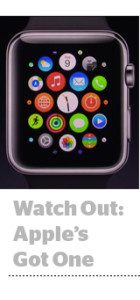 Considering Apple’s user-centric ethos, there’s a slim chance the watch’s tiny screen will ever be host to advertising in the traditional sense.
Considering Apple’s user-centric ethos, there’s a slim chance the watch’s tiny screen will ever be host to advertising in the traditional sense.
It’s a move that would be “antithetical to the whole way that Apple works,” said Mark Yackanich, CEO of ad company Genesis Media.
“The question to ask ourselves is not a media-specific question, but rather: How does the watch integrate into the broader ecosystem of Apple products to make life easier from a technology perspective?” Yackanich said. “And from there, there are a lot of interesting things you can do.”
The watch feels like a “natural extension” for Apple, said Adam Foroughi, CEO of app marketing platform AppLovin.
“It’s a move toward being an accessory for every part of your life,” Foroughi said. “The watch provides a connected device that follows you everywhere you go and feeds data back to other Apple devices.”
The potential boon to mobile attribution is clear. Imagine you’re walking down the street and you’re served a location-based ad or coupon for Sephora on your shiny new iPhone 6. You enter the store, pick up a product and bring it over to the checkout counter. If you use Apple Watch (or your phone) to pay, then the loop is neatly closed.
“That creates a fully attributed bridge between the phone, the watch, the campaign you saw and the actual transaction in the store,” Foroughi said. “Brands will have a better opportunity to understand what dollars are being spent in terms of transactions related to foot traffic, and as that starts happening, more and more dollars will start to shift toward mobile.”
But location is table stakes by this point, said Yackanich, who noted that the true potential of a product like Apple Watch is “the opportunity to link a more personal profile to a user that’s authenticated to that person in a way that connects health information, behavior and commerce. The rest we already know through first- and third-party cookie sets.”
Apple, however, has made its stance on advertiser access to data from HealthKit, its new health and fitness monitoring app, quite clear: Hands off. That’s going to make tapping the watch for advertising purposes a little tricky.
“It’s a little bit of the uncanny valley of data collection,” Yackanich said. “So for now, we have another screen sitting on a person’s wrist and that positioning is going to be challenging to use for advertising as it’s currently envisioned.”
Of course, the question remains as to whether consumers will actually use a watch, or even their phone, to make mobile payments. Up until now, although players like Samsung and Pebble have tossed their watches into the ring, the wearables market has still been waiting for its big boom. But according to Pascal Caillon, GM at the North American arm of proximity marketing vendor Proxama, the time is right.
“This comes at a time when most new Android phones feature NFC technology, but still haven’t generated significant consumer interest. This is where Apple typically shines,” Caillon said. “It jump-starts its competition by educating consumers on the benefits of a technology through use cases that create value for consumers [and] also garners a critical mass of users, especially in the US, that will attract larger service providers, such as brands and merchants. Few handset makers and even mobile operators can claim such ubiquity.”
And Apple’s move into wearables does in fact coincide with growing consumers’ interest in wearable devices. According to Nielsen, 51% of consumers who have said they’re in-market to buy a wearable are looking for fitness bands, while 44% pointed to smart watches (Apple is a combination of both) and 25% said they’d buy a head-mounted display – which means there could be hope yet for Google Glass.
But what Apple has, and Google doesn’t, is a community of stylish, interconnected products that play well together, said Yackanich.
“Google is not set up to be a hardware creator. Apple is. And whatever they’re selling, people will buy,” he said. “If wearables are going to grow, Apple is going to start it.”













